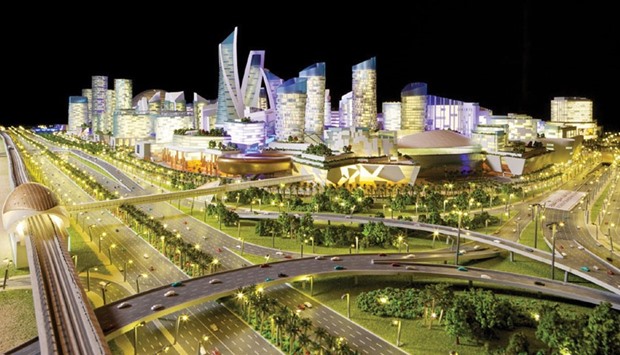Morgan Parker’s first job at one of Dubai’s biggest developers was to tell his bosses everything that was wrong with their $20bn plan to build the world’s largest mall and 100 hotels to surround it.
A lot, it turned out. The former head of the Rockefeller family’s Rose Rock real estate firm took Dubai Holding’s Mall of the World project back to the drawing board, pushing a scaled-down plan that doesn’t require breaking records to attract attention.
Even the watered-down plans will face challenges in winning backers. Political turmoil, falling oil prices and declining Dubai home values have made Gulf-based financiers skittish about new investments. And big international funds have been wary of Dubai real estate since the near-default in 2009 after a spending spree on trophy projects including man-made islands.
“Most institutional investors don’t like to take on development risk especially in times like this,” said Gaurav Shivpuri, broker Jones Lang LaSalle’s head of capital markets for the Middle East and North Africa. “The preference is usually for operating assets that provide income right away but again with the right price point some may be persuaded.”
Dubai Holding’s new plan includes three malls to be built in stages instead of one big shopping centre, allowing the project to grow gradually depending on demand and investment. The mantra, Parker says, is now on realistic projects that generate cash quickly instead of expensive buildings intended to burnish Dubai’s international image.
“We are avoiding the biggest of this and tallest of that,” said the 41-year-old, a former Morgan Stanley and Macquarie Group banker. “Dubai is maturing as a city and investors are looking for rational projects. At the end of the day, the money is made by the tenants paying the rent and they are looking for projects that function.”
The project is still ambitious by any city’s measure. The 850,000sq m (9.15mn sq ft) of retail space would combine a Rodeo Drive-like fashion district with street shops and traditional malls. About 35 office buildings would be scattered throughout the development to help reduce congestion and to support shops and restaurants across the area. The project’s 8,000 homes will range from luxury apartments to student housing and staff accommodation.
Although Dubai Holding is backed by ruler, the project’s $20bn price tag means the company needs institutional investors. Stints as an investment banker gives Parker the understanding of what they’re seeking in real estate projects, while his role leading mall developer and owner Taubman Asia and work at Australia’s Lend Lease Group give practical development knowledge.
“This is a very very large project,” he said. “It’s going to require an enormous amount of work and capital to bring to fruition.”
Dubai Holding is in talks with six investors such as regional pension and sovereign funds to gauge demand, Parker said. He declined to provide names but said he aims to conclude partnership agreements with investors this year, and is seeking real estate funds with long-term investors.
Jones Lang LaSalle’s Shivpuri said regional investors are still interested in Dubai real estate as they tend to disregard geopolitical and legal risks that put off international investors.
However Richard Bradstock, head of Middle East at real estate investor IP Global Ltd, said local investment is under pressure because of the oil price slump and political instability.
“We are seeing enormous outflow of money from the region to places like the UK, Australia, Germany and the US,” he said. “Mostly because of geopolitical risks.”
Home prices fell throughout 2015, with Standard & Poor’s and Phidar Advisory both predicting a further decline this year. Phidar’s index of international demand for Dubai real estate dropped by 83% last year, driven by exchange-rate fluctuations.
Part of Parker’s job was coming up with something that works better for the customers, tenants and the city itself. He recalls Dubai Holding managing director Ahmed bin Byat telling him the original Mall of the World plan announced a year ago was “problematic” and the company needed to come up with “something better, something that works.” The development sits on a 400-acre (162-hectare) site that’s equal to 72 city blocks on Dubai’s main Sheikh Zayed Road.
The initial designs would have created “the biggest traffic jam in the history of the world right in the centre of Dubai” because employees and visitors would have to come and leave every day, Parker said.
To avoid adding to the gridlock, the development planned now will have 22 entrances and exits on four roads, compared with around five exits for locations such as Dubai Marina and Downtown, Parker said. It would utilise metro, tram, bus, and cycling routes as well as walkways and a free carbon-neutral electric shuttle, all emanating from a central station.
Parker had been planning a second TV series for National Geographic in Hong Kong when he got a call from a recruiter about a potential job in Dubai. After leaving the Rockefellers’s Rose Rock, the Australian was dividing his time between roles on the boards of several companies and producing the show, in which he would take a 10,000km (6,200-mile) motorcycle ride through India to promote eight charities.
Parker said a major challenge will be enabling people to walk around the development, especially during summer months when the temperature soars as high as 45 degrees Celsius (113 degrees Fahrenheit). He commissioned a scientific study on how the body reacts to heat under various scenarios.
“Without shade, people can walk about 176 metres and then they’re done,” Parker said. “You give people shade, they can go further and if you allow them an opportunity to walk into air-conditioned space at 24 degrees Celsius, the body temperature drops down to a neutral position.”

Dubai Holding’s new plan for the Mall of the World project includes three malls to be built in stages instead of one big shopping centre, allowing the project to grow gradually depending on demand and investment.


